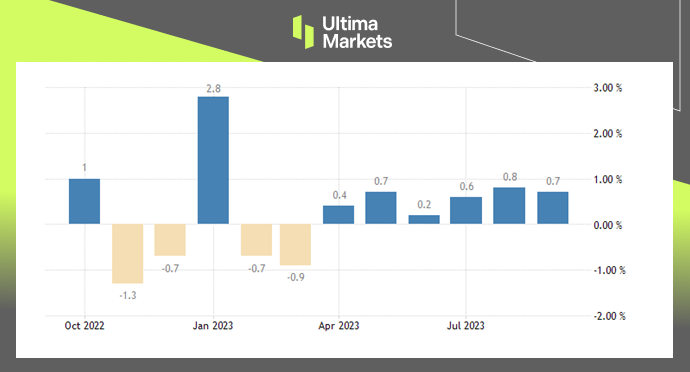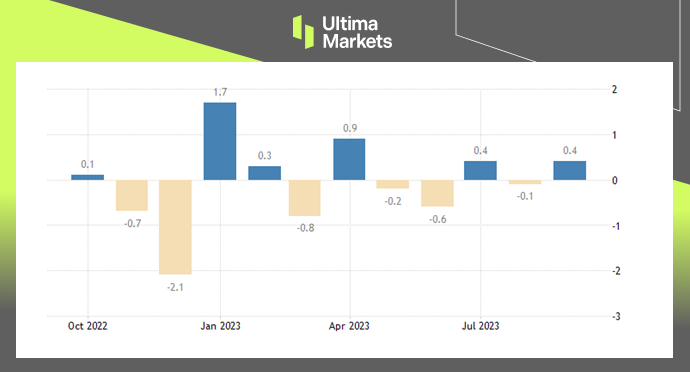
U.S. Retail Sales Thrived in September 2023
As we delve into the latest economic data for September 2023, it becomes evident that the U.S. retail and manufacturing sectors are experiencing notable developments.
This comprehensive report highlights the key statistics and trends that are shaping these critical segments of the American economy.
Consumer Spending Takes the Lead
In September, U.S. retail sales increased by a solid 0.7%, building on the previous month’s 0.8% rise. This is good news, especially given the challenges posed by high prices and borrowing costs. Consumers continued to show confidence by spending more than expected, defying economic uncertainties.
Leading Categories
Several categories saw remarkable growth:
- Miscellaneous store retailers: Up by 3%
- Non-store retailers: A solid increase of 1.1%
- Motor vehicles and parts dealers: An impressive 1% growth
- Gasoline stations: 0.9% increase
It’s important to note that these figures don’t account for inflation, making these results even more noteworthy.

(Retail Sales, United States Department of Commerce)
Diverse Sectors Register Growth
In addition to the standout categories, other sectors also did well:
- Food services and drinking places: 0.9% rise
- Health and personal care stores: An 0.8% increase
- Food and beverage stores: 0.4% growth
- General merchandise stores: Also up by 0.4%
However, some sectors experienced declines:
- Electronics and appliances: Decreased by 0.8%
- Clothing stores: A drop of 0.8%
- Building material and garden equipment stores: A slight dip of 0.2%
Even when we exclude automobile sales, gasoline, building materials, and food services, retail sales still rose by a solid 0.6%. These results are a testament to consumer resilience in the face of economic challenges.
Strong U.S. Manufacturing Output Growth
Manufacturing Shines
In September, production in U.S. factories increased more than expected, even though there were strikes in the automobile industry that limited the production of motor vehicles. This is additional proof that the economy finished the third quarter with strength.
Positive Manufacturing Data
The Federal Reserve reported a 0.4% increase in manufacturing output last month. In contrast, the data for August was revised downwards, showing a 0.1% decrease in factory production, instead of the previously reported 0.1% increase. Economists surveyed by Reuters had predicted a 0.1% uptick in factory output.
Year-on-Year Analysis
Looking at the year-on-year basis, production saw a 0.8% decline in September, with no change in the third quarter. Durable goods manufacturing output increased at an annualized rate of 2.3%, but this was offset by a 2.4% decline in nondurable manufacturing.

(Manufacturing Production MoM, FED)
Summary
In summary, the data for September 2023 highlights a resilient U.S. retail sector and a manufacturing industry that’s bouncing back from challenges. Consumers are spending with confidence despite rising prices, and manufacturers are adapting positively.
Staying informed and agile in these sectors is essential for businesses and investors looking to seize the opportunities presented by these trends.
Explore Ultima Markets News Hub
Stay Informed with the Latest Updates – Dive into Our Articles
Disclaimer
Comments, news, research, analysis, price, and all information contained in the article only serve as general information for readers and do not suggest any advice. Ultima Markets has taken reasonable measures to provide up-to-date information, but cannot guarantee accuracy, and may modify without notice. Ultima Markets will not be responsible for any loss incurred due to the application of the information provided.
Copyright © 2023 Ultima Markets Ltd. All rights reserved.
Pourquoi trader des métaux et des matières premières avec Ultima Markets ?
Ultima Markets offre l'environnement de coûts et d'échange le plus compétitif pour les matières premières les plus répandues dans le monde.
Commencer à traderSurveiller le marché en déplacement
Les marchés sont sensibles aux changements de l'offre et de la demande
Attrayant pour les investisseurs uniquement intéressés par la spéculation sur les prix
Liquidité profonde et diversifiée sans frais cachés
Pas de bureau de négociation et pas de requotes
Exécution rapide via le serveur Equinix NY4








